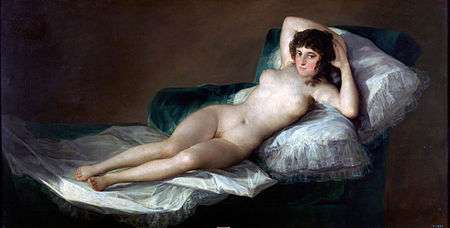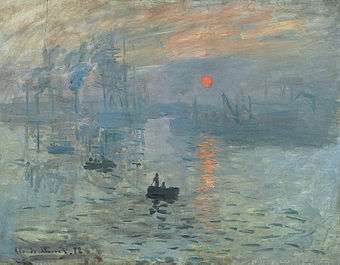Olympia (Manet)
| Olympia | |
|---|---|
 | |
| Artist | Édouard Manet |
| Year | 1863 |
| Medium | Oil on canvas |
| Dimensions | 130.5 cm × 190 cm (51.4 in × 74.8 in) |
| Location | Musée d'Orsay, Paris |
Olympia is a painting by Édouard Manet, first exhibited at the 1865 Paris Salon, which shows a nude woman ("Olympia") lying on a bed being brought flowers by a servant. Olympia was modelled by Victorine Meurent and Olympia's servant by the art model Laure. Olympia's confrontational gaze caused shock and astonishment when the painting was first exhibited because a number of details in the picture identified her as a prostitute. The French government acquired the painting in 1890 after a public subscription organized by Claude Monet. The painting is on display at the Musée d'Orsay, Paris.
Content
What shocked contemporary audiences was not Olympia's nudity, nor the presence of her fully clothed maid, but her confrontational gaze and a number of details identifying her as a demi-mondaine or prostitute.[1] These include the orchid in her hair, her bracelet, pearl earrings and the oriental shawl on which she lies, symbols of wealth and sensuality. The black ribbon around her neck, in stark contrast with her pale flesh, and her cast-off slipper underline the voluptuous atmosphere. "Olympia" was a name associated with prostitutes in 1860s Paris.[2]
The painting is modelled after Titian's Venus of Urbino (1538).[3] Whereas the left hand of Titian's Venus is curled and appears to entice, Olympia's left hand appears to block, which has been interpreted as symbolic of her sexual independence from men and her role as a prostitute, granting or restricting access to her body in return for payment. Manet replaced the little dog (symbol of fidelity) in Titian's painting with a black cat, which traditionally symbolized prostitution. Olympia disdainfully ignores the flowers presented to her by her servant, probably a gift from a client. Some have suggested that she is looking in the direction of the door, as her client barges in unannounced.
The painting deviates from the academic canon in its style, characterized by broad, quick brushstrokes, studio lighting that eliminates mid-tones, large color surfaces and shallow depth. Unlike the smooth idealized nude of Alexandre Cabanel's La naissance de Vénus, also painted in 1863, Olympia is a real woman whose nakedness is emphasized by the harsh lighting.[1] The canvas alone is 51.4 x 74.8 inches, which is rather large for this genre-style painting. Most paintings that were this size depicted historical or mythological events, so the size of the work, among other factors, caused surprise. Finally, Olympia is fairly thin by the artistic standards of the time and her relatively undeveloped body is more girlish than womanly. Charles Baudelaire thought thinness more indecent than fatness.[4]
The model for Olympia, Victorine Meurent, became an accomplished painter in her own right.[5]
Precedents
In part, the painting was inspired by Titian's Venus of Urbino (c. 1538), which in turn refers to Giorgione's Sleeping Venus (c. 1510). Léonce Bénédite was the first art historian to explicitly acknowledge the similarity to the Venus of Urbino in 1897.[6] There is also some similarity to Francisco Goya's La maja desnuda (c. 1800).[7]
There were also pictorial precedents for a nude woman, attended by a black servant, such as Ingres' Odalisque with a Slave (1842), Léon Benouville's Esther with Odalisque (1844) and Charles Jalabert's Odalisque (1842).[8] Comparison is also made to Ingres' Grande Odalisque (1814). Unlike other artists, Manet did not depict a goddess or an odalisque but a high-class prostitute waiting for a client.
 Giorgione, Sleeping Venus (c. 1510), also known as the Dresden Venus
Giorgione, Sleeping Venus (c. 1510), also known as the Dresden Venus Titian, Venus of Urbino (1538)
Titian, Venus of Urbino (1538)

Critical reaction

Though Manet's The Luncheon on the Grass (Le déjeuner sur l'herbe) sparked controversy in 1863, his Olympia stirred an even bigger uproar when it was first exhibited at the 1865 Paris Salon. Conservatives condemned the work as "immoral" and "vulgar."[1] Journalist Antonin Proust later recalled, "If the canvas of the Olympia was not destroyed, it is only because of the precautions that were taken by the administration." The critics and the public condemned the work alike. Even Émile Zola was reduced to disingenuously commenting on the work's formal qualities rather than acknowledging the subject matter, "You wanted a nude, and you chose Olympia, the first that came along".[9] He paid tribute to Manet's honesty, however, "When our artists give us Venuses, they correct nature, they lie. Édouard Manet asked himself why lie, why not tell the truth; he introduced us to Olympia, this fille of our time, whom you meet on the sidewalks."[10]
Olympia's Maid
Although originally overlooked, the figure of the maid in the painting, modelled by a woman named Laure, has become a topic of discussion among contemporary scholars. As T. J. Clark recounts of a friend’s disbelief in the revised 1990 version of The Painting of Modern Life: “you’ve written about the white woman on the bed for fifty pages and more, and hardly mentioned the black woman alongside her.”[11] Olympia was created 15 years after slavery had been abolished in France but racist stereotypes had continued. In some cases, the white prostitute in the painting is described using racist language. "References to Blackness thus invaded the image of white Olympia, turning her into the caricatural and grotesque animal that Black people are frequently made to represent in the nineteenth century"[12]
Many critics have applauded Manet in his use of white and black in the painting, an alternative to the tradition of chiaroscuro. Charles Bernheimer has said,
The black maid is not [...] simply a darkly colored counterpart to Olympia's whiteness, but rather an emblem of the dark, threatening, anomalous sexuality lurking just under Olympia's hand. At least, this is the fantasy Manet's servant figure may well have aroused in the male spectator of 1865.[13]
Black feminists have rejected his reading and argue that it is not for artistic convention that Manet included Laure but to create an ideological binary between black and white, good and bad, clean and dirty and "inevitably reformulates the Cartesian perspectival logic that allows whiteness to function as the only subject of consideration".[14] When paired with a lighter skin tone, the Black model stands in as signifier to all of the racial stereotypes of the West.
The Confrontational Gaze and The Oppositional Gaze
In Lorraine O' Grady's essay titled "Olympia's Maid: Reclaiming Black Female Subjectivity",[15] she asserts, "Olympia's maid, like all other 'peripheral Negroes'", is a robot conveniently made to disappear into the background drapery. While the confrontational gaze of Olympia is often referenced as the pinnacle of defiance toward patriarchy, the oppositional gaze of Olympia's maid is ignored; she is part of the background with little to no attention given to the critical role of her presence.
O'Grady points out that we know she represents 'Jezebel and Mammy' "and best of all, she is not a real person...", rather she is object to the objectified and excluded from sexual difference according to Freudian theory.[15] While Olympia looks directly at the viewer, her maid, too, is looking back.[16] In her essay "Mammy, Jezebel, Sapphire and Their Homegirls: Developing an Oppositional Gaze toward the Images of Black Women", Catherine West concludes that by claiming an oppositional gaze we can identify, criticize, resist and transform these and other oppressive images of Black women.[17]
Homages
- A Modern Olympia, Paul Cézanne, c. 1873/74.
- Odalisque I. Looking at Manet. Olympia and A Family, Louis le Brocquy.
- Portrait (Futago), Yasumasa Morimura.[18]
- "Somms Recreating Old Masters: Series 1", Mark Shipway, c. 2015.[19]
References and sources
- References
- 1 2 3 "Édouard Manet's Olympia by Beth Harris and Steven Zucker". Smarthistory. Khan Academy. Retrieved 11 February 2013.
- ↑ Clark, T.J. (1999) The Painting of Modern Life: Paris in the Art of Manet and His Followers. Revised edition. Princeton: Princeton University Press, p.86.
- ↑ Millett-Gallant, Ann (2010-08-03). The Disabled Body in Contemporary Art. Palgrave Macmillan. pp. 31–. ISBN 9780230109971. Retrieved 6 September 2014.
- ↑ Reff, Theodore. (1976) Manet: Olympia. London: Allen Lane, p. 57. ISBN 0713908076
- ↑ "The naked truth" The Guardian, 3 October 2008. Retrieved 18 December 2014.
- ↑ Reff, p. 48.
- ↑ Meyers, Jeffrey. (2004). Impressionist Quartet: The Intimate Genius of Manet and Morisot, Degas and Cassatt, p. 35; Beruete y Moret, Aureliano. (1922). Goya as portrait painter, p. 190.
- ↑ The Puzzle of Olympia. Phylis A. Floyd, 19th Century Art Worldwide, 2012. Retrieved 5 December 2012.
- ↑ Quoted in Honour, H. and J. Fleming, (2009) A World History of Art. 7th edn. London: Laurence King Publishing, p. 708. ISBN 9781856695848
- ↑ Andersen, Frits (2004). Karen-Margarethe Simonsen; Marianne Ping Huang; Mads Rosendahl Thomsen, eds. Reinventions of the Novel: Histories and Aesthetics of a Protean Genre. Rodopi. p. 79. ISBN 9789042008434.
- ↑ Clark, T. J. (1984). The Painting of Modern Life. Princeton University Press. ISBN 978-0691009032.
- ↑ Lathers, Maria (2013). Dictionary of Artists' Models. London: Routledge. pp. 315–316.
- ↑ Bernheimer, Charles (1989). "Manet's Olympia: The Figuration of Scandal". Poetics Today. 10: 255–277.
- ↑ Brown, Timothy Paul (2001). "Black Radical Feminism and the Reclamation of Identity". Third Text. 55: 43–50.
- 1 2 O'Grady, Lorraine. "Olympia's Maid: Reclaiming Black Female Subjectivity". The Feminism and Visual Culture Reader. pp. 174–187.
- ↑ hooks, bell. "The Oppositional Gaze: Black Female Spectator". The Feminism and Visual Cultural Reader. New York: Routledge, 2003: Amelia Jones. pp. 94–105.
- ↑ West, Carolyn M (2008-01-01). "Mammy, Jezebel, Sapphire and their homegirls: Developing an "oppositional gaze" toward the images of Black women".
- ↑ "Yasumasa Morimura, Portrait (Futago)".
- ↑ "Mark Shipway, "Somms Recreating Old Masters: Series 1"".
- Sources
- Ross King. The Judgment of Paris: The Revolutionary Decade that Gave the World Impressionism. New York: Waller & Company, 2006 ISBN 0-8027-1466-8. See pages 105-108.
- Eunice Lipton. Alias Olympia: A Woman's Search for Manet's Notorious Model & Her Own Desire. Ithaca: Cornell University Press, 1999. ISBN 0-8014-8609-2
- V.R. Main. A Woman With No Clothes On. London: Delancey Press, 2008 ISBN 978-0-9539119-7-4.
External links
| From Smarthistory |
| Wikimedia Commons has media related to Olympia by Manet. |
- Phylis A. Floyd, The Puzzle of Olympia
- Seibert, Margaret Mary Armbrust. A Biography of Victorine-Louise Meurent and Her Role in the Art of Édouard Manet. Diss. The Ohio State University, 1986.

